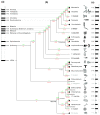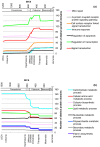Strong functional patterns in the evolution of eukaryotic genomes revealed by the reconstruction of ancestral protein domain repertoires
- PMID: 21241503
- PMCID: PMC3091302
- DOI: 10.1186/gb-2011-12-1-r4
Strong functional patterns in the evolution of eukaryotic genomes revealed by the reconstruction of ancestral protein domain repertoires
Abstract
Background: Genome size and complexity, as measured by the number of genes or protein domains, is remarkably similar in most extant eukaryotes and generally exhibits no correlation with their morphological complexity. Underlying trends in the evolution of the functional content and capabilities of different eukaryotic genomes might be hidden by simultaneous gains and losses of genes.
Results: We reconstructed the domain repertoires of putative ancestral species at major divergence points, including the last eukaryotic common ancestor (LECA). We show that, surprisingly, during eukaryotic evolution domain losses in general outnumber domain gains. Only at the base of the animal and the vertebrate sub-trees do domain gains outnumber domain losses. The observed gain/loss balance has a distinct functional bias, most strikingly seen during animal evolution, where most of the gains represent domains involved in regulation and most of the losses represent domains with metabolic functions. This trend is so consistent that clustering of genomes according to their functional profiles results in an organization similar to the tree of life. Furthermore, our results indicate that metabolic functions lost during animal evolution are likely being replaced by the metabolic capabilities of symbiotic organisms such as gut microbes.
Conclusions: While protein domain gains and losses are common throughout eukaryote evolution, losses oftentimes outweigh gains and lead to significant differences in functional profiles. Results presented here provide additional arguments for a complex last eukaryotic common ancestor, but also show a general trend of losses in metabolic capabilities and gain in regulatory complexity during the rise of animals.
Figures




Similar articles
-
Evolution and classification of myosins, a paneukaryotic whole-genome approach.Genome Biol Evol. 2014 Feb;6(2):290-305. doi: 10.1093/gbe/evu013. Genome Biol Evol. 2014. PMID: 24443438 Free PMC article.
-
Function-selective domain architecture plasticity potentials in eukaryotic genome evolution.Biochimie. 2015 Dec;119:269-77. doi: 10.1016/j.biochi.2015.05.003. Epub 2015 May 15. Biochimie. 2015. PMID: 25980317 Free PMC article.
-
Algorithms for computing parsimonious evolutionary scenarios for genome evolution, the last universal common ancestor and dominance of horizontal gene transfer in the evolution of prokaryotes.BMC Evol Biol. 2003 Jan 6;3:2. doi: 10.1186/1471-2148-3-2. Epub 2003 Jan 6. BMC Evol Biol. 2003. PMID: 12515582 Free PMC article.
-
Concepts of the last eukaryotic common ancestor.Nat Ecol Evol. 2019 Mar;3(3):338-344. doi: 10.1038/s41559-019-0796-3. Epub 2019 Feb 18. Nat Ecol Evol. 2019. PMID: 30778187 Review.
-
Origin and evolution of eukaryotic transcription factors.Curr Opin Genet Dev. 2019 Oct;58-59:25-32. doi: 10.1016/j.gde.2019.07.010. Epub 2019 Aug 26. Curr Opin Genet Dev. 2019. PMID: 31466037 Review.
Cited by
-
A natural barrier to lateral gene transfer from prokaryotes to eukaryotes revealed from genomes: the 70 % rule.BMC Biol. 2016 Oct 17;14(1):89. doi: 10.1186/s12915-016-0315-9. BMC Biol. 2016. PMID: 27751184 Free PMC article.
-
A daily-updated tree of (sequenced) life as a reference for genome research.Sci Rep. 2013;3:2015. doi: 10.1038/srep02015. Sci Rep. 2013. PMID: 23778980 Free PMC article.
-
This Déjà vu feeling--analysis of multidomain protein evolution in eukaryotic genomes.PLoS Comput Biol. 2012;8(11):e1002701. doi: 10.1371/journal.pcbi.1002701. Epub 2012 Nov 15. PLoS Comput Biol. 2012. PMID: 23166479 Free PMC article.
-
The Co-4 locus on chromosome Pv08 contains a unique cluster of 18 COK-4 genes and is regulated by immune response in common bean.Theor Appl Genet. 2015 Jun;128(6):1193-208. doi: 10.1007/s00122-015-2500-6. Epub 2015 Mar 25. Theor Appl Genet. 2015. PMID: 25805316
-
Evolution of protein domain repertoires of CALHM6.PeerJ. 2024 Jan 2;12:e16063. doi: 10.7717/peerj.16063. eCollection 2024. PeerJ. 2024. PMID: 38188152 Free PMC article.
References
-
- Baldauf S. An overview of the phylogeny and diversity of eukaryotes. J Systemat Evol. 2008;46:263–273. http://www.plantsystematics.com/qikan/manage/wenzhang/jse08060.pdf
-
- Valentine J, Collins A, Meyer P. Morphological complexity increase in metazoans. Paleobiology. 1994;20:131–142. http://www.jstor.org/pss/2401015

